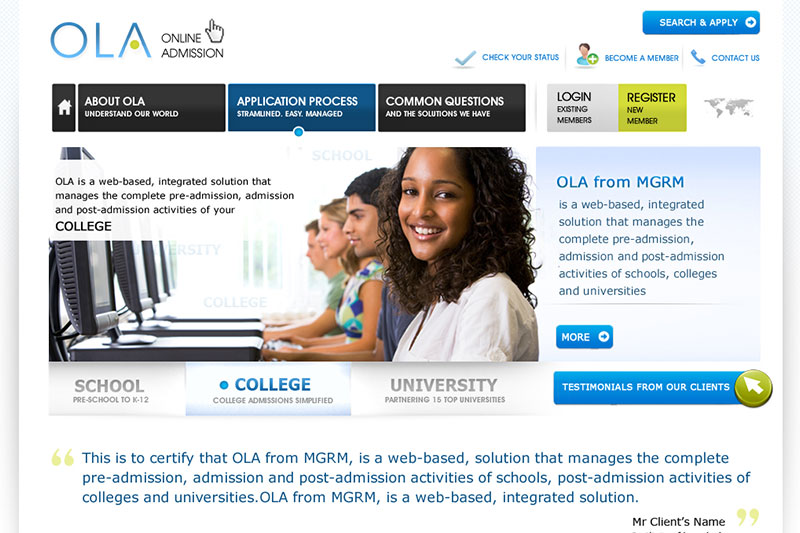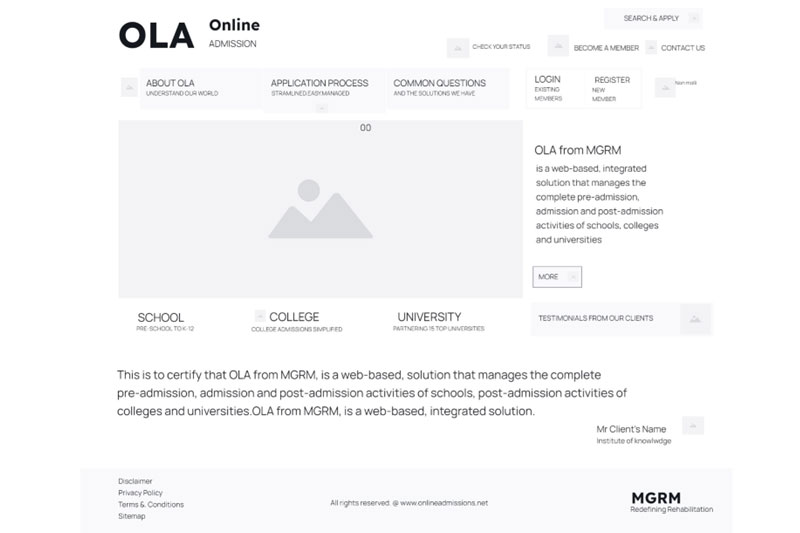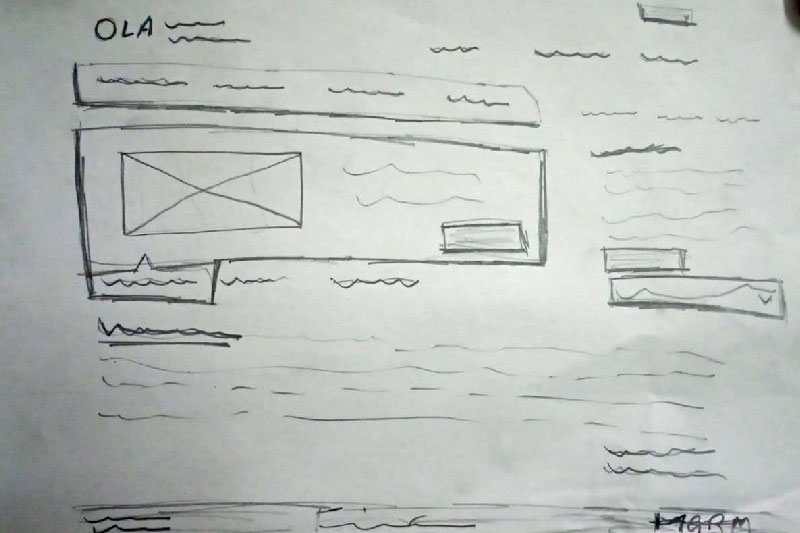


The project, undertaken by MGRM Net Ltd., aimed to revolutionize the admission process through the development of the Online Admission (OLA). The primary goal was to create a centralized, user-friendly platform that seamlessly manages pre-admission, admission, and post-admission activities for schools, colleges, and universities.
The OLA application, focused on streamlining traditionally complex workflows for administrators and providing an intuitive, positive experience for applicants. The project aimed to overcome challenges related to fragmentation, system integration, user adoption, and scalability within educational institutions.
The successful launch of OLA resulted in a transformative solution that significantly simplified admission procedures, fostered a positive user experience, and provided educational institutions with a scalable and adaptable tool for managing admissions. The project's results were marked by improved efficiency, transparent communication, and a positive impact on both administrators and applicants within the education sector.



The project addressed several critical challenges, user needs, and business requirements in the education admission process:
User Needs: Simplified workflows for administrators, a transparent and clear application process for applicants.
Business Requirement: Streamlined processes to reduce inefficiencies and delays.
User Needs: Adaptability to changing educational needs.
Business Requirement: Cultivating a culture of continuous improvement through regular updates and enhancements.
Technical Constraints: Compatibility with diverse legacy systems, adherence to accessibility standards, and optimization for performance.
Business KPIs: Improved efficiency in admission processes, positive user feedback, increased user adoption rates, and ongoing system adaptability.
Administrator’s needs: Streamlined workflows, seamless integration, effective training, and ongoing support.
Applicant’s needs: Intuitive application interface, clarity in the admission process, and timely communication on application status.
User Needs: Seamless integration to avoid disruption in established workflows.
Business Requirement: Compatibility with diverse legacy systems in educational institutions.
User Needs: Effective training for administrators to navigate the new platform.
Business Requirement: Ensuring user adoption for a smooth transition.
User Needs: Intuitive application for applicants, clarity in each stage of the admission process.
Business Requirement: Positive user experiences to attract and retain applicants.
User Needs: Accommodation of institutions of varying sizes.
Business Requirement: Design for scalability while remaining adaptable to evolving educational landscapes.
User Needs: Responsive system during peak admission periods.
Business Requirement: Optimization for reliability to ensure uninterrupted service.



Process: Developed a centralized, user-friendly platform that streamlined pre-admission, admission, and post-admission activities.
Objective Addressed: Addressed the problem of fragmented admission processes by providing a cohesive, end-to-end solution.
Process: Ensured seamless integration with existing systems through careful collaboration with IT teams and compatibility testing.
Objective Addressed: Overcame the challenge of integration, providing administrators with a system that complements their established workflows.
Process: Developed comprehensive training materials and ongoing support systems for administrators.
Objective Addressed: Mitigated challenges related to user adoption by empowering administrators with the necessary skills to navigate the new platform.
Process: Designed the application with scalability in mind, accommodating institutions of varying sizes.
Objective Addressed: Ensured adaptability to the diverse needs of educational institutions, overcoming the challenge of scalability.
Process: Fine-tuned the application for optimal performance, minimizing loading times and ensuring responsiveness.
Objective Addressed: Overcame challenges related to performance, providing a reliable system, especially during peak admission periods.
Process: Conducted user research, created wireframes, and developed high-fidelity prototypes to optimize the user experience for applicants.
Objective Addressed: Improved user satisfaction by providing a clear and intuitive application process.

Improved Efficiency: Reduced time and effort in admission processes for administrators.
Positive User Feedback: Received high satisfaction ratings from both administrators and applicants.
Increased User Adoption: Achieved a smooth transition with a high adoption rate among educational institutions.
Optimized Performance: Maintained system responsiveness during peak admission periods.
Industry Recognition: OLA received industry acclaim for its transformative impact on education admission processes.
User Experience Awards: Acknowledged for its intuitive design and positive user experiences.
Positive Impact: OLA significantly improved the efficiency and transparency of admission processes, positively impacting both administrators and applicants.
Collaborative Success: The success of the project was attributed to collaborative efforts, stakeholder engagement, and a user-centric design approach.
User-Centricity is Key: Prioritizing user needs and involving stakeholders throughout the design process is crucial for success.
Adaptability Matters: Educational technology landscapes evolve rapidly; building adaptability into the system is essential for sustained success.
Effective Communication: Transparent and continuous communication with stakeholders contributes to project success.
Administrators: "OLA has simplified our workload and made the admission process more efficient."
Applicants: "The application process was smooth and transparent. I was kept informed at every step."
User Feedback Loop: Establish a continuous feedback loop to address emerging needs and challenges.
Integration Enhancements: Explore opportunities for deeper integration with educational systems and emerging technologies.